Amanda Barrett One of Three Newly Named VPs
Horrific Week for Ozy’s Carlos Watson
Was Cosby-R. Kelly Story Too Good to Check?
Modern-Day Child Slavery Makes Evening News
Host of NPR’s ‘Radio Ambulante’ Wins MacArthur
CBS Names Black Hearst Exec to Run L.A. Outlets
Race, Diversity Figure in Features Group Awards
Passings:
Nick Oza, Photographer
Myron Dewey, Native Filmmaker, Journalist
Lloyd Goings, Salesman for Native Press
Short Takes: Errol Louis; press freedom for journalists of color; Mark Thompson and Maria Ressa; digitizing Afro-American newspapers; David Betancourt and Marvel Voices; “inside America’s most dangerous penal system”; Johnson Publishing Co. landmark plaque; Reporters Committee for Freedom of the Press Awards; Indian Country Today; Asian American Foundation, AAJA and hate crimes; Amy X. Wang; monitoring public broadcast diversity; Freddy Rolón; DeWayne Wickham; Killing of Colombian journalist; investigating journalists’ bank accounts; little attention to Ethiopian crisis; Journal-isms assistant editor position.
Homepage photo: AP photo introduces news cooperative’s diversity statements
Support Journal-ismsAmanda Barrett One of Three Newly Named VPs
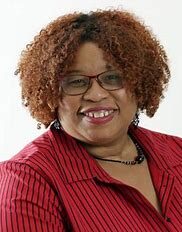 Amanda Barrett (pictured), a 14-year veteran of the Associated Press, was promoted Wednesday to vice president and head of news audience, a new role that will make her the highest ranking African American ever in the AP’s news operations.
Amanda Barrett (pictured), a 14-year veteran of the Associated Press, was promoted Wednesday to vice president and head of news audience, a new role that will make her the highest ranking African American ever in the AP’s news operations.
In her new job, one of three announced by Julie Pace, named executive editor on Sept. 1, “Amanda will have a relentless focus on how AP’s news is consumed online, by consumers on AP News and customers on AP Newsroom, as well on social media.
“At the heart of Amanda’s job is the audience experience — those we reach through our customers and the audiences we are growing on our own platforms and social media accounts. Amanda will also continue to oversee the Nerve Center and play a leading role in AP’s diversity and inclusion efforts, with the goal of ensuring that these priorities are shared and implemented across News.”
Others tapped were Brian Carovillano, who “takes on the new role of Vice President and Head of News Investigations, Enterprise, Grants and Partnerships,” and David Scott, who becomes vice president and head of news strategy and operations.
After the George Floyd killing by police last year, Barrett, then a deputy managing editor, wrote a piece headlined, “AMERICAN DIARY: To be black and a journalist at this moment.”
“Part of me wants to go off and join the fight,” Barrett confided. “To put aside my journalistic reserve and give full voice to my anger, my disappointment that my country doesn’t always live up to its lofty ideals of equality and justice. To build a brighter future like it seemed on ‘Star Trek,’ where races, nationalities and even species lived together in mutual respect and Lt. Uhura’s presence as a respected, competent black officer assured little Amanda of her place among them.
“But I’m doing my part right where I am. I’m telling stories that help readers understand the world around them. I’m sharing the voices of the unheard and holding those in power accountable. Just as important, I am working to make our newsrooms more accurately reflect the communities we cover and to make our storytelling and our decision-making more inclusive.
“My voice is the voice of facts and context. My voice is the hope that they can bring the understanding and, eventually, the equality that my country’s founding documents promise.
“My space is the newsroom.
“I’m good here.”
- Richard Fowler, Forbes: As More Oppressive Voting Rules Emerge, Black Women Journalists Lead The Headlines

Horrific Week for Ozy’s Carlos Watson
The online magazine Ozy.com is not targeted at African Americans, but its co-founder Carlos Watson, its public face, is a Black journalist turned entrepreneur who, notably, managed to secure an early investment from the German media conglomerate Axel Springer, seemingly an out-of-the-box source.
Watson, who turned 52 on Wednesday, has had a horrific week.
Jon Allsop summarized that day in Columbia Journalism Review, “On Sunday, Ben Smith, the media columnist at the [New York] Times, reported that Samir Rao, a top executive at Ozy, a digital-media company, impersonated a YouTube staffer on a call with potential investors.
“Since then, Ozy has come under a harsh spotlight, with follow-up stories exploring other deceptions including its leaders’ apparent practice of attributing their own praiseful quotes about the company to other outlets that had quoted them; meanwhile, an Ozy festival in Miami was postponed, and Carlos Watson, the CEO, stepped back as host of tonight’s Documentary Emmy Awards.
“Ozy’s board initially backed Watson’s statement attributing Rao’s conduct to a mental-health crisis — but yesterday, it commissioned an investigation and asked Rao to go on leave.”
Watson replied to Smith’s piece on Monday with “a few important points to set the record straight,” but that did not stop the tide of negative news.
- Brian Welk and Antoinette Siu, The Wrap: Ozy Media Chairman Marc Lasry Resigns
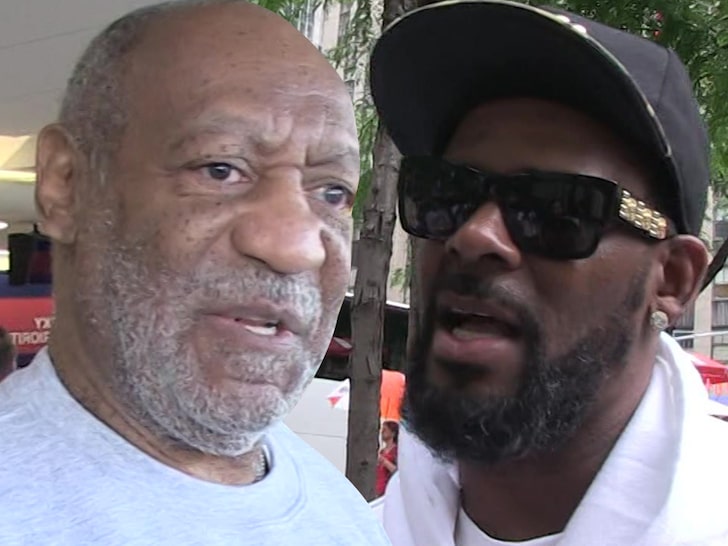
Was Cosby-R. Kelly Story Too Good to Check?
“Though Absolutely No One Asked, Bill Cosby Apparently Has Some Thoughts About R. Kelly,” proclaimed a headline Wednesday on The Root. “R. KELLY GOT ‘RAILROADED’ IN SEX CRIMES TRIAL!!!: Cosby Rep Predicts Successful Appeal,” said TMZ. “Bill Cosby feels R. Kelly ‘got railroaded’ at sex-trafficking trial,” declared The New York Post.
And Thursday: “Bill Cosby Says R. Kelly Was ‘Railroaded’ In Guilty Verdict, Proving They Are Cut From The Same Damn Cloth,” bannered Madam Noire.
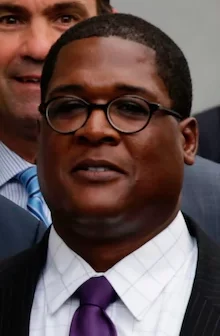 Wrong. Wrong. Wrong. Wrong, said the man being quoted, Cosby spokesman Andrew Wyatt (pictured). In a telephone conversation Wednesday with Journal-isms, Wyatt threw in the term “fake news” and just about said that’s what the media do to get attention.
Wrong. Wrong. Wrong. Wrong, said the man being quoted, Cosby spokesman Andrew Wyatt (pictured). In a telephone conversation Wednesday with Journal-isms, Wyatt threw in the term “fake news” and just about said that’s what the media do to get attention.
For one thing, despite The Root headline, reporters did ask him his thoughts about R. Kelly.
For another, Wyatt said, he told the reporters that Cosby had no position on Kelly’s conviction. “Mr. Cosby said nothing,” Wyatt said. The spokesman did say, speaking for himself and referring to Black men, “what we’ve seen is a lot of men get railroaded.”
Wyatt said he was sought out by TMZ and the New York Post, not by The Root [or Madam Noire], and told TMZ he would not go on camera about the issue.
- Lorraine Ali, Los Angeles Times: The music industry coddled R. Kelly. Television helped take him down
- Deepti Hajela, Associated Press: In R. Kelly verdict, Black women see long-overdue justice
- Eric Deggans, NPR: R. Kelly And Britney TV Docs Tap Into ‘Consequence Culture,’ Not Cancel Culture (Aug. 23)
- dream hampton, Washington Post: R. Kelly’s been convicted. Now it’s time to focus on the safety and future of survivors.
Modern-Day Child Slavery Makes Evening News
“The sunset over Lake Volta masks the sinister depths below. Rickety vessels are filled with young boys, trapped — like the fish they catch — and forced to dive deep to free entangled nets,” Debora Patta reported Tuesday for the “CBS Evening News.”
“Driven by poverty, thousands of children are fishing there — some work in the family business, but many have been sold into modern-day slavery.
“The United Nations estimates one in 10 children — about 160 million kids — is forced to work. Many are doing so in horrifying conditions. . . .”
It was a rare story about modern-day slavery on a major American network evening newscast.
The Ghanaian embassy in Washington did not respond to a request for comment.
From Ghana, Eric Peasah told Journal-isms he has led the rescue of more than 1,000 children from the Volta Lake in Ghana and other girls from different countries.
“There was a story on New York Times about my work in [2006] that [led] to a show on Oprah,” Peasah messaged Thursday. “But there is the need for more stories to create awareness.”
- Ana Carmo with Urmila Bhoola, Special Rapporteur on Contemporary Forms of Slavery: Contemporary slavery often ‘invisible and clandestine’: UN rights expert (audio) (Oct. 30, 2019)
- Human Rights Council, United Nations: Follow up report of the Special Rapporteur on torture and other cruel, inhuman or degrading treatment or punishment on his follow-up visit to the Republic of Ghana [PDF]
Host of NPR’s ‘Radio Ambulante’ Wins MacArthur
“Daniel Alarcón, an Assistant Professor of Journalism, a celebrated novelist and co-creator of the award-winning Spanish-language podcast Radio Ambulante, has been named a 2021 MacArthur Fellow by the John D. and Catherine T. MacArthur Foundation, the foundation announced today,” Columbia Journalism School reported Tuesday.
“Also known as the ‘Genius Grant,’ the fellowship recognizes ‘people of outstanding talent’ across a variety of disciplines, including artists, writers, scientists, teachers, and entrepreneurs. Described as an investment in the ‘originality, insight, and potential’ of its recipients, the fellowship comes with a stipend of $625,000 to encourage the continuation of their work. . . .”
NPR’s Leila Fadel asked Alarcon in an interview Tuesday, “You are multicultural, if you will — born in Peru, grew up in Alabama. How much does that influence the way you approach storytelling?”
Alarcón responded, “Well, I grew up in the 1980s in a very nice sort of quiet suburb of Birmingham, Ala., at a time when Peru was going through a cataclysmic war and terrorism and violence. And the juxtaposition of those two experiences really left a mark on me.
“I feel like I emerged from adolescence with a kind of survivor’s guilt wondering by what accident of migration my family had been spared something that was really traumatic for my family directly. And so I guess I was always, especially in my early fiction, trying to figure out who I would have been if I’d stayed — if we’d stayed — and then more to the point as a journalist, trying to sort of extrapolate that to other countries and try to understand other realities. So it’s always there in my work.”
 Ibram X. Kendi, the celebrated author and academician who wrote “How to Be an Antiracist,” is the most well-known of the winners of color. But there is also writer and curator Nicole R. Fleetwood (pictured), whose book “Marking Time: Art in the Age of Mass Incarceration” won the 2021 National Book Critics Circle Award for criticism.
Ibram X. Kendi, the celebrated author and academician who wrote “How to Be an Antiracist,” is the most well-known of the winners of color. But there is also writer and curator Nicole R. Fleetwood (pictured), whose book “Marking Time: Art in the Age of Mass Incarceration” won the 2021 National Book Critics Circle Award for criticism.
“Dr. Fleetwood, 48, who is also a professor of media, culture and communication at New York University, curated an exhibition by the same name that won praise after its debut at MoMA PS1 last year,” Matt Stevens and Jennifer Schuessler reported for The New York Times. “In the book and the accompanying museum exhibition, Dr. Fleetwood delves into the cultural and aesthetic significance of the art made by incarcerated people. . . .”
CBS Names Black Hearst Exec to Run L.A. Outlets
 “Continuing a sweeping overhaul of its TV station leadership, CBS on Monday named veteran executive Joel Vilmenay (pictured) as general manager of the company’s two broadcast outlets in Los Angeles: KCBS-TV Channel 2 and KCAL-TV Channel 9,” Meg James reported for the Los Angeles Times.
“Continuing a sweeping overhaul of its TV station leadership, CBS on Monday named veteran executive Joel Vilmenay (pictured) as general manager of the company’s two broadcast outlets in Los Angeles: KCBS-TV Channel 2 and KCAL-TV Channel 9,” Meg James reported for the Los Angeles Times.
“The Washington, D.C., native plans to join CBS in Los Angeles on Oct. 18. Vilmenay has spent two decades with Hearst Television, including as president and general manager of its NBC affiliate in New Orleans, WDSU-TV Channel 6, since 2007.
“Vilmenay also will be responsible for the digital news operation, CBSN Los Angeles, and the L.A. stations’ local news website.
“He replaces Jay Howell, who was ousted in July after a six-month internal review into alleged misconduct in the stations group. CBS opened its inquiry after a Los Angeles Times investigation in January revealed allegations of racism, misogyny and misconduct by longtime CBS managers. The series found that the highest-ranking station managers cultivated an environment that included bullying female executives and blocking efforts to hire and retain Black journalists. . . .”
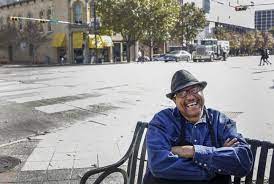
“I would compare shoe shining to an artist painting a painting,” Jessie Thibideaux said in an award-winning piece by Bronte Wittpenn in the Austin American-Statesman. “He’s taking his time, he’s making sure the colors are right, the patterns are right, the balance is right. I see an empty canvas I’m about to turn into a masterpiece.” (Credit: Bronte Wittpenn/Austin American-Statesman)
Race, Diversity Figure in Features Group Awards
The Post and Courier in Charleston, S.C., the Los Angeles Times and columnists Jenee Osterheldt of the Boston Globe and Tony Norman of the Pittsburgh Post-Gazette were among the winners in Society for Features Journalism Excellence-in-Features Awards.
Osterheldt was cited for the Globe series “A Beautiful Resistance.”
The judges said, “A beautiful online presentation of this series accompanies lovely, evocative essays, videos and photography on Black culture and history in the United States. The project is well-packaged and easy to navigate. While so much of the media’s coverage has focused – and rightly so – on the longstanding historical injustices visited upon Black Americans, this project explores a little-addressed corner of what it means to be Black in America: The joy, resilience and history as told by the Black Americans living it.”
Osterheldt told readers about the series in December: “It wasn’t just what I’ve seen this summer and this year. It’s kind of the long lasting, persistent narrative of what it means to be Black in America as defined by [gatekeepers] in the media, which tends to always be through the lens of brutality, always through the lens of inequity and suffering. And while white supremacy is a reality in America and so is inequity, and blackness is not a burden, that suffering does not define us. It’s not who we are.”
Osterheldt won first place in the commentary category for the 200,000-circulation and up category. She was also a winner in the “diversity in digital features” category.
 The Post and Courier won 10 awards, including one for Jennifer Berry Hawes’ (pictured) feature specialty writing portfolio.
The Post and Courier won 10 awards, including one for Jennifer Berry Hawes’ (pictured) feature specialty writing portfolio.
“These are powerful stories of people, masterfully told,” the judges said. “Even when writing about personalities who lived centuries ago – as she did in a deeply reported, deftly constructed project about long-neglected Black landmarks – Jennifer manages to summon their humanity.
“As finely crafted as that ambitious piece is, the two contemporary tales are even better – one about a sheriff’s fall from grace after a traumatic sniper incident and the other about the healing process that drew people and a dog together after a bicyclist’s fatal accident. In each case, Jennifer works the story tirelessly, winning the trust of her subjects and staying with the tale through its natural denouement. This is superb work that subtly commands the reader’s empathy without any false notes of sentimentality or lazy writing.”
Hawes also won for “Forsaken History: In Charleston’s 350th Year, Key Places and Stories in City’s Racial Past Long Neglected.”
Evan F. Moore of the Chicago Reader was praised for “This Land Is My Land.”
“This story is an impressive and moving account of one man’s journey to reclaim a part of his family’s land and history,” judges said. “Though told as a personal narrative, the scope of the story is wide – Evan deftly uncovers America’s forgotten and ugly history in the Tulsa Massacre and violence against Black Americans, while simultaneously celebrating Black communities and entrepreneurship. A moving narrative arc paired with one of the most impactful issues of our time make this feature a winner.”
Among the Los Angeles Times’ 15 awards was one for “The Chicano Moratorium: 50 Years Later.” The judge said, “This is an exceptionally well-done and eye-opening series about the 1970 protest against the Vietnam War, and the presentation is gorgeous. The writing, especially the ‘Loss of Innocence’ story by Daniel Hernandez, is evocative and clear.
Another winning team, for diversity in digital features, was Laura Bauer, Judy Thomas, Eric Adler of the Kansas City Star for “Throwaway kids.”
“Over the past few years, there has been a fear that journalism that makes a difference will disappear from regional newspapers. Well, The Kansas City Star is here to say, ‘Not today, not today.’ This engrossing, five-part dive into the foster-home-to-prison-pipeline — and how it has negatively impacted thousands of Americans who now languish behind bars — is well-reported, solidly written and accompanied by an abundance of excellent videos, photos and podcast-style interviews with the writers. There are so many entry points and each offers insight. In short: fantastic work.”
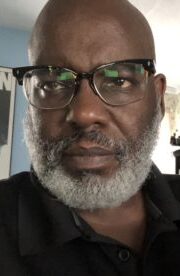 Norman (pictured) of the Pittsburgh Post-Gazette, who is president of the National Society of Newspaper Columnists, won first place in his circulation category for a general commentary portfolio. “The thing we love most about these columns is that they’re built from passion but informed by reporting,” judges said. “And while the reporting is essential, it’s never really noticeable – in a good way. The details are sprinkled into the stories at the right moments, never sacrificing the personality or the emotion that makes these pieces so readable. And there’s purpose here, not only in relating to topical matters but also in trying to help us all better understand the world.”
Norman (pictured) of the Pittsburgh Post-Gazette, who is president of the National Society of Newspaper Columnists, won first place in his circulation category for a general commentary portfolio. “The thing we love most about these columns is that they’re built from passion but informed by reporting,” judges said. “And while the reporting is essential, it’s never really noticeable – in a good way. The details are sprinkled into the stories at the right moments, never sacrificing the personality or the emotion that makes these pieces so readable. And there’s purpose here, not only in relating to topical matters but also in trying to help us all better understand the world.”
The Virginian-Pilot in Norfolk won 11 awards, including one for Joanne Kimberlin’s “Afghan Activist in Newport News Caught Between Heart and Homeland as Peace Talks Begin With Taliban.”
Judges said, “This is a superbly constructed story about Sarina Faizy, an Afghan activist living in Virginia. We were hooked from the opening sentences: ‘From a house in Newport News, Sarina Faizy watches events on the other side of the globe. A foot in both worlds. A knot in her stomach.’ In the piece, Joanne paints a picture of Faizy in her American home (yes, sometimes she breaks taboo and goes swimming!) and interweaves her current life with her role as a teenage, female member of Kandahar’s provincial council. The tone is upbeat but honest about the brutalities that await women such as Faizy if the Taliban regain power.”
In addition, Robert Morast, Sarah Feldberg and Alex Fong of the San Francisco Chronicle won a first-place award for integrated storytelling — told “through the integrated use of print, online, social media, video and any other platform” — for “The Throughline.“
“This wildly ambitious project looks at how the coronavirus and the Black Lives Matter movement will influence San Francisco’s future – its bike paths and city layout, its artists and . . . its education, its search for racial justice,” judges said. “Using print and online resources, the result is a vibrant, thought-provoking and entertaining piece of stellar work that looks at what the city could be. We often say that journalists write the first draft of history; with this glorious project, The Chronicle is writing the first draft of the future.”
Passings
Nick Oza, Photographer
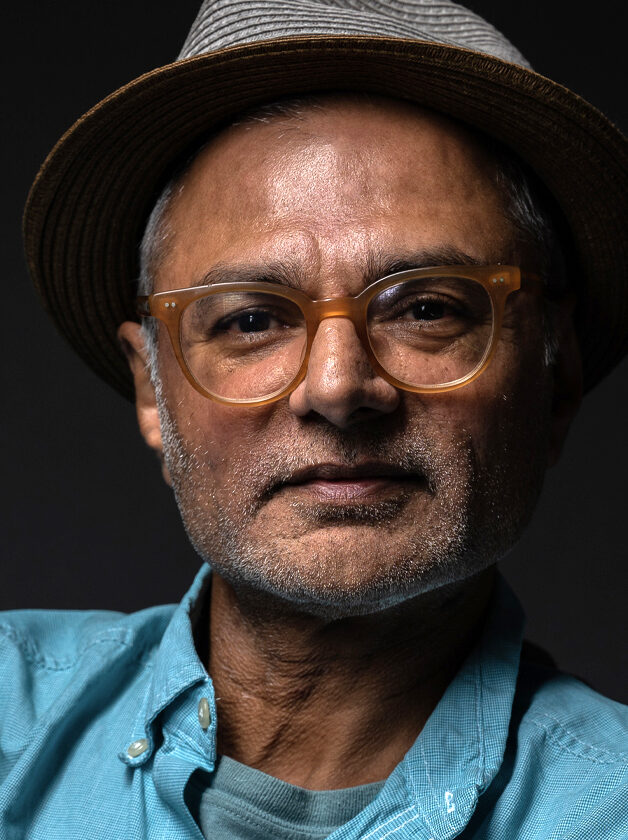 Nick Oza (pictured), a two-time Pulitzer Prize-winning photographer who produced stark images of resilience and triumph in the face of natural and man-made adversity, has died,” Richard Ruelas reported Tuesday for the Arizona Republic. “He was 57.
Nick Oza (pictured), a two-time Pulitzer Prize-winning photographer who produced stark images of resilience and triumph in the face of natural and man-made adversity, has died,” Richard Ruelas reported Tuesday for the Arizona Republic. “He was 57.
“Oza, who joined The Arizona Republic’s photo staff in 2006, was known for an immersive style of photography, working as a documentarian and following individuals through life-changing events. His signature images captured emotion, often expressed through a subject’s eyes or hands.
“Though he often was with people as they suffered through trying times — cleaning up a hurricane-ravaged house, anxious about a looming deportation — Oza had a disarming personality that put subjects at ease.
“Though he spoke limited Spanish, Oza became well known in the community of Latino immigrants in Phoenix.
“He often documented protest actions. And he was often pegged to cover longer-term projects about immigrant issues and people.
“Many of those projects came from Oza himself, whose drive to find compelling visuals naturally spilled into discovering great stories.
“Oza died early Monday. He had been hospitalized since Sept. 3, when a single-vehicle car accident in Phoenix left him seriously injured. . . .”
Myron Dewey, Native Filmmaker, Journalist
 “Myron Dewey (pictured), a filmmaker, professor and journalist, passed away in a fatal car accident early Sunday morning in Yomba, Nev., sources confirmed to Native News Online,“ Darren Thompson reported for Native News Online. “He was 49.
“Myron Dewey (pictured), a filmmaker, professor and journalist, passed away in a fatal car accident early Sunday morning in Yomba, Nev., sources confirmed to Native News Online,“ Darren Thompson reported for Native News Online. “He was 49.
“Dewey founded Digital Smoke Signals, a media production company that shared live frontline footage during the 2016 protests against the Dakota Access Pipeline (DAPL) near the Standing Rock Indian Reservation in North Dakota. His drone footage of the DAPL protests garnered recognition for the cause and elevated his status as a journalist covering environmental and Indigenous issues. . . .”
“Dewey was Newe-Numah/ Paiute-Shoshone from the Walker River Paiute Tribe, Agui Diccutta Band (Trout Eaters) and Temoke Shoshone,” Vincent Schilling wrote for Indian Country Today.
Lloyd Goings, Salesman for Native Press
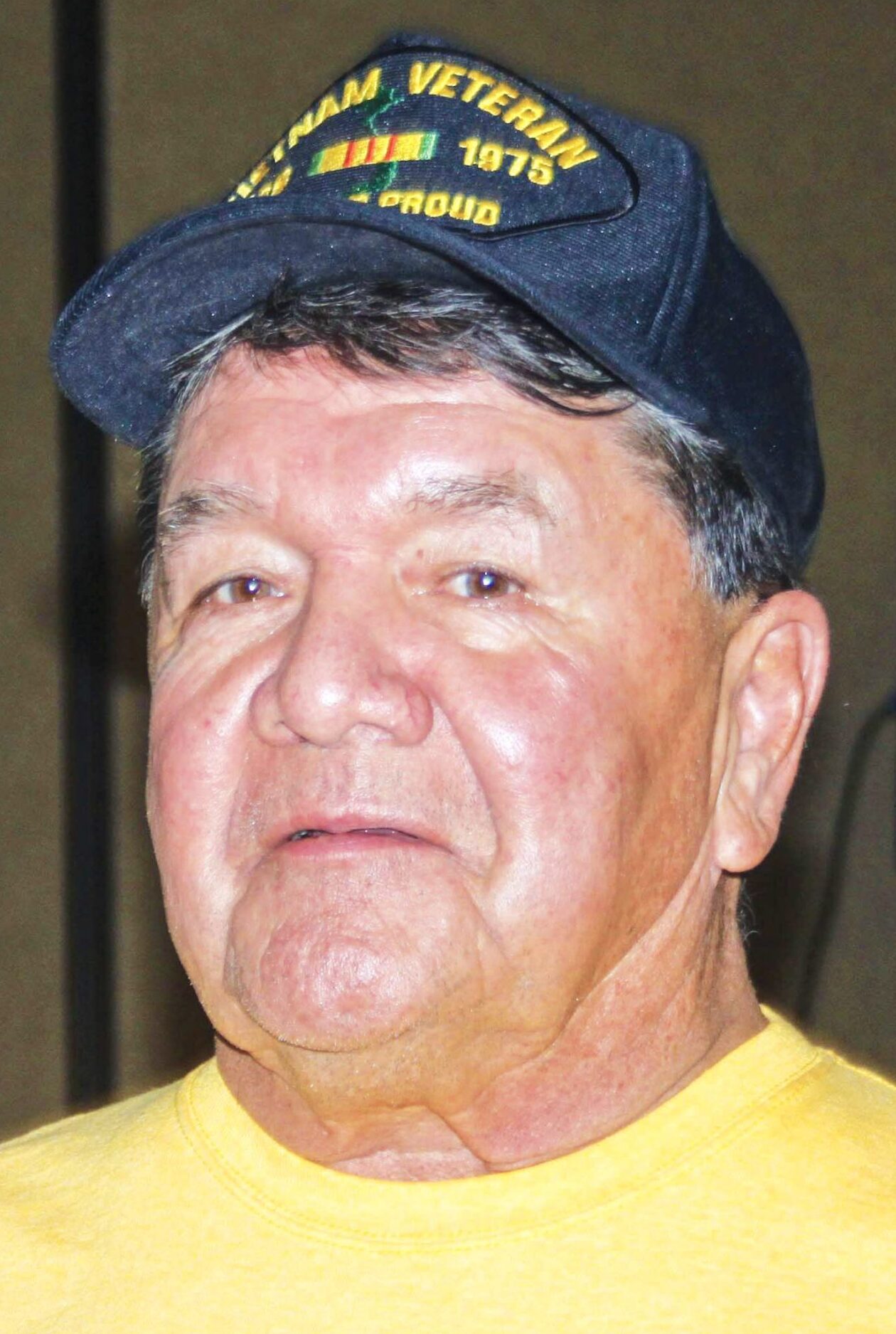 Lloyd Goings (pictured), Oglala, sold advertising for the Lakota Times and later the Native Sun News in Rapid City, S.D. “And boy could he sell,” Tim Giago wrote Monday for indianz.com.
Lloyd Goings (pictured), Oglala, sold advertising for the Lakota Times and later the Native Sun News in Rapid City, S.D. “And boy could he sell,” Tim Giago wrote Monday for indianz.com.
“He even amazed me because he was bringing in accounts none of my sales people had ever been able to reach. It turned out [that] Lloyd was also a used car salesman on the side. He always had an old car that he was promoting and quite often ended up selling the car to one of my employees.”
Giago also wrote, “A few weeks ago we put up a sign on our office door that all visitors had to wear a mask. We even put a box of masks at the front door. Well, Lloyd didn’t like the idea at all, but he complied with it. He forced himself to wear a mask at our office, but refused to wear one outside of the office. He was against getting vaccinated also.
“Last week Lloyd paid the price for neglecting to take care of himself. He came down with COVID-19, fought it for a couple of days at home, but when they finally got him to a hospital it was too late.
“We lost our good friend Lloyd Goings last Tuesday. . . .” He would have been 75 on Oct. 8.
- Justin Baragona, Daily Beast: ‘The View’ Gets Emotional While Addressing On-Air COVID Chaos
- Rong-Gong Lin II and Marissa Evans, Los Angeles Times: Black L.A. residents have highest COVID hospitalization rate: ‘A deplorable reality’
- New York Amsterdam News: Vaccine uptick found in African Americans, but access and misinformation still confounds community
- Erin Woo, New York Times: How Covid Misinformation Created a Run on Animal Medicine
Short Takes
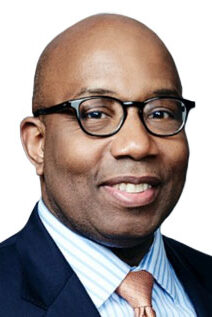 “This is my final regular column for The News,“ Errol Louis (pictured) wrote Thursday for the New York tabloid Daily News, telling readers he would soon be writing for New York magazine. “It has been a dream job that took me into dicey housing projects, noisy street protests, Supreme Court hearings and political conventions. I made it to election rallies, criminal trials, art exhibits and private dinners with several mayors. You could go anywhere, meet anybody, write about what you learned — and then do it all over again the next day.” Louis’ column on New York politics began in 2004. Alden Global Capital’s $633 million purchase this year of the Chicago-based Tribune newspaper chain, of which the News is a part, prompted a series of buyouts, cutbacks and resignations.
“This is my final regular column for The News,“ Errol Louis (pictured) wrote Thursday for the New York tabloid Daily News, telling readers he would soon be writing for New York magazine. “It has been a dream job that took me into dicey housing projects, noisy street protests, Supreme Court hearings and political conventions. I made it to election rallies, criminal trials, art exhibits and private dinners with several mayors. You could go anywhere, meet anybody, write about what you learned — and then do it all over again the next day.” Louis’ column on New York politics began in 2004. Alden Global Capital’s $633 million purchase this year of the Chicago-based Tribune newspaper chain, of which the News is a part, prompted a series of buyouts, cutbacks and resignations.
- “While press freedom is established in the ‘supreme law of the land,’ those who are charged with enforcing the law tend to enforce it selectively,” Ben Camacho and Jayrol San Jose wrote Wednesday for the Poynter Institute’s The Collective, a “newsletter by journalists of color for journalists of color and our allies.” Camacho and San Jose wrote, “The first night that we covered the protesting in downtown Los Angeles, police lines became impassable and often unapproachable radiuses that promised a use of force (usually by the pointing of a rubber-coated-steel-bullet gun barrel our way). While these types of interactions with police and sheriff’s departments were the norm for us, we witnessed taller, older, agency-backed, white press photographers cross the police lines with a simple nod. . . .”
 “Former New York Times CEO and BBC director-general Mark Thompson is teaming up with Filipino journalist and press freedom advocate Maria Ressa (pictured) to spearhead a global initiative to support independent media outlets and journalists globally,” Sara Fischer reported Wednesday for Axios.
“Former New York Times CEO and BBC director-general Mark Thompson is teaming up with Filipino journalist and press freedom advocate Maria Ressa (pictured) to spearhead a global initiative to support independent media outlets and journalists globally,” Sara Fischer reported Wednesday for Axios.
- The AFRO-American Newspapers has a daunting task ahead: . . .In July 2021, AFRO Charities received a $535,000 grant from #StartSmall, Jack Dorsey’s philanthropic initiative, to support the digitization of The AFRO American Newspapers’ full photo archive, and the creation of an artificial intelligence-informed online research interface,” the Local Media Association reported. “This grant will cover the staffing and equipment needs for the first two years of this project. . . .”
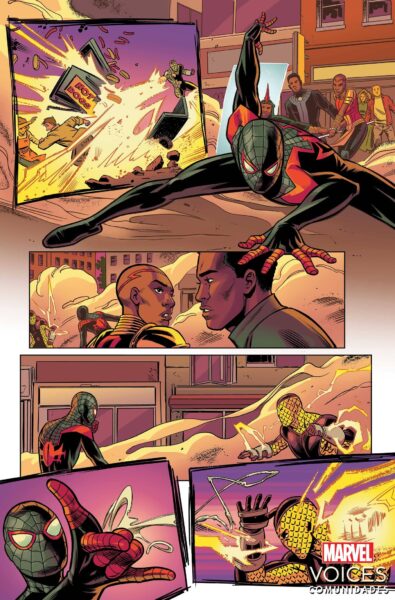
 David Betancourt (pictured), a reporter focusing on comic book culture for The Washington Post, has “written a Miles Morales/Spider-Man story for Marvel Voices: Comunidades #1, which will be in stores on Nov. 10,” he wrote on LinkedIn. Betancourt says on the Marvel site, “The chance to be the first writer that is both Puerto Rican and African American to craft a story for Miles Morales was an opportunity I could not pass up. There isn’t a Super Hero in all of comics that means more to me and I’m excited to have contributed to this Spider-Man’s mythos.”
David Betancourt (pictured), a reporter focusing on comic book culture for The Washington Post, has “written a Miles Morales/Spider-Man story for Marvel Voices: Comunidades #1, which will be in stores on Nov. 10,” he wrote on LinkedIn. Betancourt says on the Marvel site, “The chance to be the first writer that is both Puerto Rican and African American to craft a story for Miles Morales was an opportunity I could not pass up. There isn’t a Super Hero in all of comics that means more to me and I’m excited to have contributed to this Spider-Man’s mythos.”
- “A five-part series taking readers inside America’s most dangerous penal system earned The Marshall Project and Mississippi Today the 2021 Collier Prize for State Government Accountability,” the University of Florida announced Wednesday. The $25,000 award, offered by the University of Florida College of Journalism and Communications (UFCJC), is one of the largest journalism prizes in the nation.” ‘Mississippi Penal System, Uncovered’ was a five-part series reported over several months by Michelle Liu, Joseph Neff, Alysia Santo, and Anna Wolfe, with data analysis and graphics from Andrew R. Calderon and Weihua Li, the Marshall Project said. “It was edited by Leslie Eaton.“
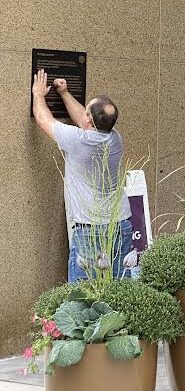 “Less than a week after a Crusader story cited the city’s years-long delay in installing a prestigious landmark plaque to the façade of the Johnson Publishing Company building at 820 S. Michigan Ave., the city on Monday, September 20, installed the historical marker (pictured), ending a four-year wait after the building was designated a Chicago landmark in 2017,” Erick Johnson reported Sept. 23 for the Chicago Crusader.
“Less than a week after a Crusader story cited the city’s years-long delay in installing a prestigious landmark plaque to the façade of the Johnson Publishing Company building at 820 S. Michigan Ave., the city on Monday, September 20, installed the historical marker (pictured), ending a four-year wait after the building was designated a Chicago landmark in 2017,” Erick Johnson reported Sept. 23 for the Chicago Crusader.
- The Reporters Committee for Freedom of the Press presented the 2021 Freedom of the Press Awards Tuesday to J. Scott Applewhite, the Associated Press; Theodore J. Boutrous, Jr., Gibson, Dunn & Crutcher LLP; Julie K. Brown, Miami Herald; Amal Clooney, Clooney Foundation for Justice; Jane Mayer, The New Yorker; and Rising Star Award Winner Laura Moscoso, Centro de Periodismo Investigativo. The 50th anniversary celebration was hosted by Kristen Welker of NBC News.
- “Breaking news: IndiJ Public Media, the company that brings you Indian Country Today, is now officially a ‘public charity’ under the law also known as a 501(c)(3) organization. We are an independent, nonprofit news company,” Mark Trahant, editor of Indian Country Today, wrote readers on Sept. 24. “This has been a long process. And a quick one.”
- “An advocacy organization founded last spring in response to anti-Asian racism announced Tuesday it has awarded more than $1.5 million in grants to combat a rise in hate incidents, including partnerships with activists in New York, Chicago and Oakland, Calif.,” David Nakamura reported Tuesday for The Washington Post. The national groups that have joined Asian American Foundation’s network include the Asian American Journalists Association.
 Amy X. Wang (pictured), who has been a senior editor at Rolling Stone, is joining the New York Times Magazine as assistant managing editor, “filling the enormous shoes vacated by Jeannie Choi in her promotion to managing editor,” Bill Wasik, editorial director of the magazine, announced Wednesday.
Amy X. Wang (pictured), who has been a senior editor at Rolling Stone, is joining the New York Times Magazine as assistant managing editor, “filling the enormous shoes vacated by Jeannie Choi in her promotion to managing editor,” Bill Wasik, editorial director of the magazine, announced Wednesday.
- “Filmmaker Grace Lee is hosting a podcast that examines public TV’s commitment to diversity, equity and inclusion amid criticism of the system’s DEI practices,” Julian Wyllie reported for Current. “The podcast, Viewers Like Us, debuted Wednesday. Episodes will be released twice a month, though its producers say that schedule may change. . . .”
 “ESPN has promoted Freddy Rolón (pictured) to SVP, Programming and Scheduling . . . ,” Veronica Villafañe reported Tuesday for her Media Moves site. “Rolón is responsible for leading the overall content strategy and schedule for ESPN’s linear networks, including ESPN, ESPN2, ESPNU and ESPNEWS. He’ll also continue to oversee all aspects of the ESPN Deportes’ linear and digital business. During his tenure at ESPN, Rolón has played an integral role in the development of the company’s content strategy to reach bilingual Hispanics consuming sports content across all of ESPN’s English-language platforms. . . .”
“ESPN has promoted Freddy Rolón (pictured) to SVP, Programming and Scheduling . . . ,” Veronica Villafañe reported Tuesday for her Media Moves site. “Rolón is responsible for leading the overall content strategy and schedule for ESPN’s linear networks, including ESPN, ESPN2, ESPNU and ESPNEWS. He’ll also continue to oversee all aspects of the ESPN Deportes’ linear and digital business. During his tenure at ESPN, Rolón has played an integral role in the development of the company’s content strategy to reach bilingual Hispanics consuming sports content across all of ESPN’s English-language platforms. . . .”
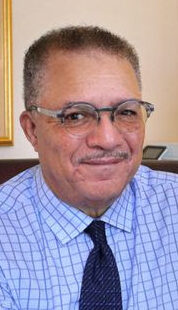 Founding Dean DeWayne Wickham (pictured) of the Morgan State University School of Global Journalism and Communication, has been given the title “Dean Emeritus,” university president David K. Wilson wrote Wickham. “You were the transformative figure who designed and built a program that quickly became a major, accredited player among schools of journalism and mass communications,” Wilson wrote. Jackie Jones succeeded Wickham on Aug. 2.
Founding Dean DeWayne Wickham (pictured) of the Morgan State University School of Global Journalism and Communication, has been given the title “Dean Emeritus,” university president David K. Wilson wrote Wickham. “You were the transformative figure who designed and built a program that quickly became a major, accredited player among schools of journalism and mass communications,” Wilson wrote. Jackie Jones succeeded Wickham on Aug. 2.
- “Colombian authorities must thoroughly investigate the killing of journalist Marcos Efraín Montalvo, determine if he was targeted for his work, and bring those responsible to justice,” the Committee to Protect Journalists said Tuesday. “On September 19, in the western city of Tuluá, an unidentified man with a pistol entered a store where Montalvo was talking with a friend and fatally shot the journalist four times in the chest, according to news reports and security footage of the shooting. The gunman did not rob the store and immediately fled on a motorcycle, according to those reports.”
- “Bangladesh authorities must immediately drop their investigations into the bank accounts of 12 members of the press and commit to allowing the media to operate freely and independently,” the Committee to Protect Journalists said Tuesday.
- “The sudden fall of Afghanistan to the Taliban has rightly drawn much of the world’s ire and attention,” Isha Sesay, Masai Ujiri, Gbenga Akinnagbe and Liz Agbor-Tabi wrote Wednesday for CNN. “And yet, much to our distress, for nearly a year the world has paid comparatively little attention to another brutal and escalating conflict; the catastrophic violence in Ethiopia that is affecting the lives of millions and imperiling stability in the Horn of Africa. . . . Two million people have been displaced, more than 350,000 are facing famine, and millions more are in need of emergency food aid. . . .”
- Journal-isms is renewing its search for an assistant editor who would love to help produce this column. Position is part time, 15 to 20 hours weekly. Please see the “About” section of this website for more information.
To subscribe at no cost, please send an email to journal-isms+subscribe@groups.io and say who you are.
Facebook users: “Like” “Richard Prince’s Journal-isms” on Facebook.
Follow Richard Prince on Twitter @princeeditor
Richard Prince’s Journal-isms originates from Washington. It began in print before most of us knew what the internet was, and it would like to be referred to as a “column.” Any views expressed in the column are those of the person or organization quoted and not those of any other entity. Send tips, comments and concerns to Richard Prince at journal-isms+owner@
View previous columns (after Feb. 13, 2016).
View previous columns (before Feb. 13, 2016)
-
- Diversity’s Greatest Hits, 2018 (Jan. 4, 2019)
- Book Notes: Is Taking a Knee Really All That? (Dec. 20, 2018)
- Book Notes: Challenging ’45’ and Proudly Telling the Story (Dec. 18, 2018)
- Book Notes: Get Down With the Legends! (Dec. 11, 2018)
- Journalist Richard Prince w/Joe Madison (Sirius XM, April 18, 2018) (podcast)
- Richard Prince (journalist) (Wikipedia entry)
- February 2018 Podcast: Richard “Dick” Prince on the need for newsroom diversity (Gabriel Greschler, Student Press Law Center, Feb. 26, 2018)
- Diversity’s Greatest Hits, 2017 — Where Will They Take Us in the Year Ahead?
- Book Notes: Best Sellers, Uncovered Treasures, Overlooked History (Dec. 19, 2017)
- An advocate for diversity in the media is still pressing for representation, (Courtland Milloy, Washington Post, Nov. 28, 2017)
- Morgan Global Journalism Review: Journal-isms Journeys On (Aug. 31, 2017)
- Diversity’s Greatest Hits, 2016
- Book Notes: 16 Writers Dish About ‘Chelle,’ the First Lady
- Book Notes: From Coretta to Barack, and in Search of the Godfather
- Journal-isms’ Richard Prince Wants Your Ideas (FishbowlDC, Feb. 26, 2016)
- “JOURNAL-ISMS” IS LATEST TO BEAR BRUNT OF INDUSTRY’S ECONOMIC WOES (Feb. 19, 2016)
- Richard Prince with Charlayne Hunter-Gault,“PBS NewsHour,” “What stagnant diversity means for America’s newsrooms” (Dec. 15, 2015)
- Book Notes: Journalists Follow Their Passions
- Book Notes: Journalists Who Rocked Their World
- Book Notes: Hands Up! Read This!
- Book Notes: New Cosby Bio Looks Like a Best-Seller
- Journo-diversity advocate turns attention to Ezra Klein project (Erik Wemple, Washington Post, March 5, 2014)
When you shop @AmazonSmile, Amazon will make a donation to Journal-Isms Inc. https://t.co/OFkE3Gu0eK
— Richard Prince (@princeeditor) March 16, 2018

